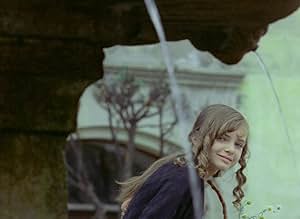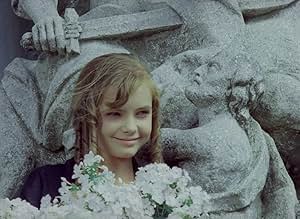VALUTAZIONE IMDb
7,0/10
12.474
LA TUA VALUTAZIONE
Un racconto surreale in cui amore, paura, sesso e religione si fondono in un mondo fantastico.Un racconto surreale in cui amore, paura, sesso e religione si fondono in un mondo fantastico.Un racconto surreale in cui amore, paura, sesso e religione si fondono in un mondo fantastico.
- Regia
- Sceneggiatura
- Star
- Premi
- 1 vittoria e 1 candidatura in totale
Josef Abrhám
- Orlík
- (voce)
- (non citato nei titoli originali)
Jana Andresíková
- Sluzka z vykriceného domu
- (non citato nei titoli originali)
Alice Auspergerová
- Sluzka
- (non citato nei titoli originali)
Recensioni in evidenza
10loff
This is one of the most astounding films I have ever seen, both visually and in terms of narrative. It consists of at least two stories (a young girl becoming a woman, a vampire story) layered on top of each other with a kind of dream-logic. It looks a dream as well. A cleaned-up DVD edition would be nice, though.
Some viewers may be offended by its' oedipal imagery, but for me this is perhaps the best fantasy-movie ever. Great actors too. It would be interesting to know if any of the people involved in this made anything as good again. A solid ten.
Some viewers may be offended by its' oedipal imagery, but for me this is perhaps the best fantasy-movie ever. Great actors too. It would be interesting to know if any of the people involved in this made anything as good again. A solid ten.
An aimless but fascinating surreal fantasy a sort of adult-oriented version of 'Alice In Wonderland' with a distinctly Eastern European flavor VALERIE AND HER WEEK OF WONDERS was a revelation for me, and I am very glad I went the extra mile to acquire a copy of it on VHS.
The narrative makes little sense and, like I said, it does not lead to anywhere in particular, but the film's trump card is the incredible (and often poetic) beauty of its images. The film ostensibly deals with the sexual awakening of a teenage girl, though the way director Jaromil Jires goes about this is extremely complex yet effortlessly captivating, and very enjoyable to boot. It takes in a variety of dazzling psycho-sexual concepts drawn from religion and mythological folklore which come off as both inextricably modern and deeply provocative still.
The film features a number of sexual perversions throughout, which is pretty amazing when considering that the lead actress was only 13 years old at the time (though nothing too explicit is ever shown): she is involved in lesbianism, incestuous/Oedipal familial relationships, and is even subjected to an attempted rape by a young priest apart from being shown in various states of undress! In this way, it would seem to cater to the tastes of practically every broad-minded film-goer one can think of (be it art-house, horror or erotica), though it is arguable how well-known this film really is which is a pity.
The few elements we find here of the traditional horror film are worth expanding upon, however: we get a number of vampires (the leading member bears an unmistakable resemblance to the Max Schreck of NOSFERATU [1922]) who periodically revert to their formerly more human and youthful selves, if only to further disorientate Valerie and ensnare her in their volatile and greedy schemes. Finally we 'witness' Valerie being burned alive at the stake (as a witch), a punishment instigated by the same priest who had earlier seduced her. Still, she manages to emerge unscathed from her every crisis, thanks to a special talisman (in the shape of a pair of earrings) and the help of her goofy but devoted brother/lover, who goes by the name of Eagle!
Jaroslava Schallerova, who plays Valerie, is lovely and utterly charming throughout, striking a perfect balance between wide-eyed innocence and a curious sexual urge. Photography, sets, costumes and make-up are all wonderful (if obviously done on a low budget) - and the accompanying choral music is beautiful indeed, almost ethereal.
The by-now deleted Redemption PAL tape presented the film in a full-screen format (I'm not sure if this is the correct ratio or not); the print was far from pristine but perfectly acceptable for an obscure item such as this. I wonder who owns the U.S. rights, as I would love to see it get a much-deserved renaissance on DVD.
I cannot say whether VALERIE AND HER WEEK OF WONDERS was actually a one-off for this Czech film-maker, as I know very little about his other work. The only Jaromil Jires film available anywhere at the moment is THE JOKE (1969), by way of a reportedly substandard edition from Facets Video on VHS and DVD.
The narrative makes little sense and, like I said, it does not lead to anywhere in particular, but the film's trump card is the incredible (and often poetic) beauty of its images. The film ostensibly deals with the sexual awakening of a teenage girl, though the way director Jaromil Jires goes about this is extremely complex yet effortlessly captivating, and very enjoyable to boot. It takes in a variety of dazzling psycho-sexual concepts drawn from religion and mythological folklore which come off as both inextricably modern and deeply provocative still.
The film features a number of sexual perversions throughout, which is pretty amazing when considering that the lead actress was only 13 years old at the time (though nothing too explicit is ever shown): she is involved in lesbianism, incestuous/Oedipal familial relationships, and is even subjected to an attempted rape by a young priest apart from being shown in various states of undress! In this way, it would seem to cater to the tastes of practically every broad-minded film-goer one can think of (be it art-house, horror or erotica), though it is arguable how well-known this film really is which is a pity.
The few elements we find here of the traditional horror film are worth expanding upon, however: we get a number of vampires (the leading member bears an unmistakable resemblance to the Max Schreck of NOSFERATU [1922]) who periodically revert to their formerly more human and youthful selves, if only to further disorientate Valerie and ensnare her in their volatile and greedy schemes. Finally we 'witness' Valerie being burned alive at the stake (as a witch), a punishment instigated by the same priest who had earlier seduced her. Still, she manages to emerge unscathed from her every crisis, thanks to a special talisman (in the shape of a pair of earrings) and the help of her goofy but devoted brother/lover, who goes by the name of Eagle!
Jaroslava Schallerova, who plays Valerie, is lovely and utterly charming throughout, striking a perfect balance between wide-eyed innocence and a curious sexual urge. Photography, sets, costumes and make-up are all wonderful (if obviously done on a low budget) - and the accompanying choral music is beautiful indeed, almost ethereal.
The by-now deleted Redemption PAL tape presented the film in a full-screen format (I'm not sure if this is the correct ratio or not); the print was far from pristine but perfectly acceptable for an obscure item such as this. I wonder who owns the U.S. rights, as I would love to see it get a much-deserved renaissance on DVD.
I cannot say whether VALERIE AND HER WEEK OF WONDERS was actually a one-off for this Czech film-maker, as I know very little about his other work. The only Jaromil Jires film available anywhere at the moment is THE JOKE (1969), by way of a reportedly substandard edition from Facets Video on VHS and DVD.
10mobia
A "coming of age" story like no other, this Czech Gothic fairytale is possibly the most lyrical film ever made. Valerie, a 13 year old staying with her grandmother while her parents are away has her first menstruation, triggering a series of interlocking dreams about lustful vampires who prey upon her youth. Despite the monstrous goings-on, the film is a buoyant and sensual pleasure to watch. The camera-work and composition never ceases to amaze and the energy of its tuneful folklike score propels the convoluted story forward effortlessly. And much credit should be given to Jaroslava Schallerova as Valerie who inhabits the role with the right balance of knowledge and wonder
Exquisite aesthetic is not enough for me, especially in itself. I want layered stratagems, nested worlds, the built of an oblique carpentry, the stuff that Lynch deals in, Wojciech Has, Ruiz; or a unified space impregnated with those things, as in the films of Antonioni or Resnais. I want magic, the spontaneous and impromptu, to well up from a familiar view of life, poetry from mundane essentials, for example the scenes of Tokyo roads in Solyaris is the most amazing rite of passage I have seen. It's passage from a tangible world.
With something like this I have no point of entry. There is no double perspective, or one foot in a world that matters. It's one long psychosexual dream stirred up from restless sleep, a young girl's guilt nightmare of a throbbing sexuality.
Life inside the grandmother's house is sterile, but outside it booms with activity and rigor. Of course once out there, the adult world poses a constant threat; its web of dark, barely comprehensible forces - none too subtly dressed up in monk garbs, there's also a demonic figure in black who addresses from the pulpit a congregation of fearful maidens - out to drink life from youth. The film appropriates suitable imagery from the vampire film.
So even though the artistry is excellent, the nightmare effective, I am just not at all interested in teasing out symbolic detail from a rural pageant. There is this one layer, and the most pressing question for the film seems to be how much of that is a dream. But again, something hardly worth puzzling over.
This is a problem in general with the surreal part of the Czech school; while inventive craftsmen, they cannot seem to layer their narratives around a solid, penetrating core. So we get beautiful but scattershot imagination. On the other hand, their comedies are superb for the same reason.
With something like this I have no point of entry. There is no double perspective, or one foot in a world that matters. It's one long psychosexual dream stirred up from restless sleep, a young girl's guilt nightmare of a throbbing sexuality.
Life inside the grandmother's house is sterile, but outside it booms with activity and rigor. Of course once out there, the adult world poses a constant threat; its web of dark, barely comprehensible forces - none too subtly dressed up in monk garbs, there's also a demonic figure in black who addresses from the pulpit a congregation of fearful maidens - out to drink life from youth. The film appropriates suitable imagery from the vampire film.
So even though the artistry is excellent, the nightmare effective, I am just not at all interested in teasing out symbolic detail from a rural pageant. There is this one layer, and the most pressing question for the film seems to be how much of that is a dream. But again, something hardly worth puzzling over.
This is a problem in general with the surreal part of the Czech school; while inventive craftsmen, they cannot seem to layer their narratives around a solid, penetrating core. So we get beautiful but scattershot imagination. On the other hand, their comedies are superb for the same reason.
Beautiful, disturbing, erotic, dreamlike... These are a few words that can sum up Jaromil Jires' deliriously bizarre fairy tale "Valerie and her Week of Wonders". Just like Richard Blackburn's sinister "Lemora", "Valerie" is a 'coming of age' tale told through a monstrous metaphor: vampires, who prey on the young to drain their innocence. Despite similarities theme-wise, these two films are quite different, and "Valerie" is certainly the most interesting of the two - a film that will definitely haunt you for life, with images so shocking today as they were back in 70's when it was released. It is 'horror' of rare ethereal beauty and poetry, and definitely one of it's kind - perfectly capturing the fear, the curiosity and the pleasure of a little girl's sexual awakening. Jaroslava Schallerová is spellbinding as the title character - a combination of Lewis Caroll's Alice and Vladimir Nabokov's Lolita. Helena Anýzová also gives a harrowing performance in the role of the grandmother, and her gradual transition from repressed Catholic old lady to a seductive, sex-crazed vampire is exquisite. Last but not least, Jires' excellent direction and Jan Curik's lush cinematography that highlights the film's "fever dream" tone help create this brilliant work of art that captures the essence of the ethereal and lyricism on celluloid unlike any other.
Lo sapevi?
- QuizJaroslava Schallerová met the love of her life, Petrem Poradou, during the making of this film. Her mother was present on the set throughout the entire shooting of this movie.
- BlooperSeveral times throughout the movie people are picking up musical instruments and music is heard as if they are playing them but the fingerings don't match up with the notes, or sometimes no hand manipulation is done at all, just the appearance of playing the instrument. In one case, Eaglet is playing the flute and plays it horizontally when it is the vertical kind.
- ConnessioniFeatured in Resurrecting the Avant-Garde (2015)
I più visti
Accedi per valutare e creare un elenco di titoli salvati per ottenere consigli personalizzati
- How long is Valerie and Her Week of Wonders?Powered by Alexa
Dettagli
- Data di uscita
- Paese di origine
- Lingua
- Celebre anche come
- Valerie en la semana de los horrores
- Luoghi delle riprese
- Azienda produttrice
- Vedi altri crediti dell’azienda su IMDbPro
Contribuisci a questa pagina
Suggerisci una modifica o aggiungi i contenuti mancanti

Divario superiore
By what name was Fantasie di una tredicenne (1970) officially released in India in English?
Rispondi















